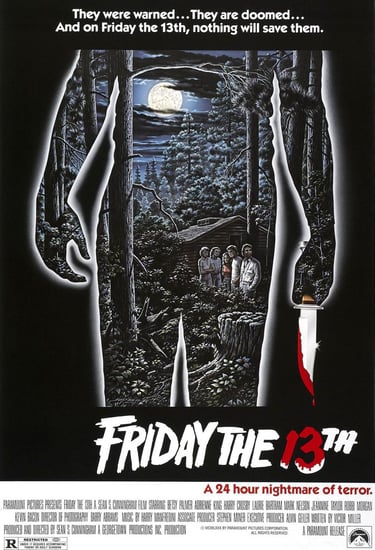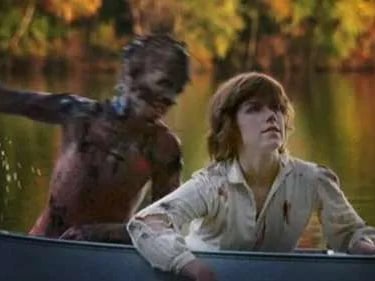Friday the 13th (1980)
"You're doomed! You're all doomed!" – Crazy Ralph


It wouldn’t exactly be the complete truth to say that the whole Slasher Central concept was an excuse to rewatch all of the Friday the 13th films and write about them, but it wouldn’t be a complete lie either. Friday the 13th (or F13) was the bedrock of the idea, which grew to encompass the whole slew of films that are covered here.
F13 is a franchise that I have a lot of time for, unlike other critics (but what’s new there?) and my affection goes back to 1981, when I wandered into the local cinema to see F13 pt2. That in itself was odd, thinking back. I had missed seeing the original on its first cinema run, but I went to see the second, which given my mania for seeing things in their correct order, is uncharacteristic. I think it was the following year that I saw pt1 on a double bill with pt2. But as the sequel started with a lengthy reprise, I had a pretty strong sense of the plot.
Hmmm, now it might be a stretch to use the word “plot” because certainly the films follow the same basic premise. Teenagers in a summer camp get slaughtered one by one until we get to the last survivor, usually female, usually virginal. It’s basically a game of ten green bottles with horny teens. They’re repetitively formulaic (but then, so were most of the Bond films until the Craig era), and I’ve never been able to figure out what their immense appeal to me is. I am a BIG Friday the 13th fan! There, I’ve said it. I wear the t-shirts, I have a prop replica hockey mask mounted on the wall, I’ve spoken to recurring “Jason” actor Kane Hodder on a few occasions, even interviewed him for a magazine and have a framed signed photo inscribed “You’re next!” as well as a couple of sculpts of the character on display. I’ve seen the films a bewildering number of times over the years – and their appeal to me endures. Friday the 13th films are like well, visual comfort food. Like a Big Mac, I love to wolf one down every now and then. (And, like a Big Mac, I consume them more often than I should.)
And there’s the ominous music, with its eerie echo chant. Once heard, it’s unforgettable and makes composer Harry Manfredini an often-overlooked genius in his field. The music contributes so much to the series.
So, let’s start this mighty franchise right at the beginning. And to be fair, it’s a humble beginning. An independent production hoping to cash in on the success of John Carpenter’s Halloween filming on location in New Jersey with a modest budget of $550.00. A bidding war for distribution of the completed film had ensued even before screenwriter Victor Miller had completed the script.
We’re at a summer camp, Camp Crystal Lake, it’s the summer of 1958 and the teenaged counsellors are enjoying a wholesome singalong by an open fire, except for one couple who break away, and sneak to a loft for some shenanigans. (This whole franchise is dependent on teenage shenanigans) Until they’re interrupted by an unknown assailant who kills them both, the camera giving the point of view of the killer, as was the case in the first “kill” in John Carpenter’s Halloween.
Cut to the title card, with “Friday the 13th” crashing its way through the screen with the sound of breaking glass.
It’s the present day, an overly chirpy young girl Annie (Robbi Morgan) is making her way to Camp Crystal Lake where she has a seasonal job as a cook. Coming to a small town, she manages to get a ride for part of her journey, while ignoring the locals’ advice to just go home because the place is cursed. As she’s told, a kid drowned there in ’57, a couple of kids were killed in ’58, another time when it was planned to re-open, the water was bad. But she’s determined to go on, and as soon as she’s dropped off, happily resumes her hitchhiking.
Meanwhile, other counsellors are similarly making their way to the camp to start their jobs and preparations because the camp is re-opening in two weeks. Owner Steve Christy (Peter Brouver) is already there, along with counsellor Alice (Adrienne King) who seems to be the target of his unwanted lust. He gives off a creepy vibe, to be honest. But that’s okay, we don’t see much of him. Practically as soon as the other counsellors start to arrive, he drives off, leaving them to their own devices to get things ready.
Meanwhile, Annie has hitched another ride, and realises something’s up when her unseen driver speeds past the turning for the Camp and slits her throat instead.
There’s a scene that I really dislike and object to, where one of the girls discovers a snake in one of the cabins and one of the others kills it with a machete. The production company hired a local snake breeder to bring along a snake – a harmless, tame one he’d hand reared, for the scene. And they actually killed it in the scene – something the breeder didn’t know was going to happen. I hate that they did that. It’s inexcusable.
Moving on, the day doesn’t really improve for these hapless teens. But to be fair, they are an annoying bunch. They encounter a deputy with no sense of humour for their antics, they’re paid a visit by Crazy Ralph (Walt Gorney) who insists on telling them the place has a death curse, and they’re all doomed… doomed. As the evening draws in (because the whole film takes place within 24 hours) there are problems with the generator, and a storm is blowing in.
One by one, the counsellors are killed, even up and coming star (well, he was up and coming in 1979 when this was filmed) Kevin Bacon who meets his end (after sex, naturally) as he lies on a bed and has an arrow thrust from under the bed, through his neck. (No way – I call BS on that kill. The killer wouldn’t have the clearance needed under the bed to ram the arrow upward with the force needed to get through the mattress and the back of Bacon’s neck, AND they’d need an arm around five feet long to reach from under the bed to hold his head still while the other pushes the arrow)
Bacon’s girlfriend is dealt an axe to the head in the toilet, another is lured out of her cabin to the arrow range, Steve Christy’s jeep breaks down in the storm and he’s stabbed. Basically, as soon as they break away from the group, they’re history.
This happens until we’re down to one – Alice. Virginal and virtuous Alice. Who starts discovering the bodies of the others, skewered to doors with arrows, skilfully arranged in trees, so they drop down at the exact moment she’s in position for the best effect or in one case, thrown in through the window of the cabin she’s hysterically barricading herself in. (Now, I realise that the poor girl’s hysterical, but I can’t help but notice she’s inside a cabin which has a door that opens outwards, and she’s barricading herself in by putting furniture against the door on the inside – which she then has to move when she sees headlight appear.)
The new arrival is Pamela Voorhees (Betsy Palmer) a nice middle-aged lady in a chunky sweater. She’s a comforting presence who seems to be Alice’s salvation for about a minute, then she starts to hear voices in her head. Pamela has issues. Big issues. She was working in the camp in 1957, when her son Jason whom she refers to as “special” drowned in the lake. The camp counsellors were negligent, and not watching him, answering their hormonal urges. Losing her son tipped Pam over to the side of bat crap crazy – and she’s the killer, assuring Alice it’ll be easier for her than it was for Jason.
After a chase around the camp, the two face off on the shore of the lake, resulting in the film’s money shot and a triumph for effects legend Tom Savini, the slow-motion decapitation of Pamela Voorhees with her own machete by Alice. (No CGI here folks, all physical effects with props)
After this onslaught, Alice pushes a canoe into the lake, and just sits there, dreamily drifting, until the police arrive the next morning. This scene is beautifully shot with the surrounding trees perfectly reflected on the still water giving it a serene dreamlike quality, which is the perfect setup for the film’s biggest shock. A disfigured Jason jumps out of the water, grabbing Alice.
In my opinion, this is one of horror cinema’s greatest shock moments, and certainly elicited some screams when shown to cinema audiences in the early eighties. (It did when I saw it reprised on my first viewing of pt2. The shrill screams and shrieks of the women behind me are pretty unforgettable)
In an epilogue that seems tacked on, Alice is alive, well and in a hospital bed with the sheriff in attendance and asks where’s the boy who dragged her into the lake but they don’t know anything about a boy…so, she muses, he must still be there.
I’ve never been totally clear about this, but as Jason was still a young boy when we see him here, I’m presuming this was a dream because there’s no mention of them having to rescue her. Given where we go from here, it might even have been a premonition of things to come – and that brings its own set of questions.
But that’s another story, for another time. Suffice it to say that we would return to Crystal Lake soon.


